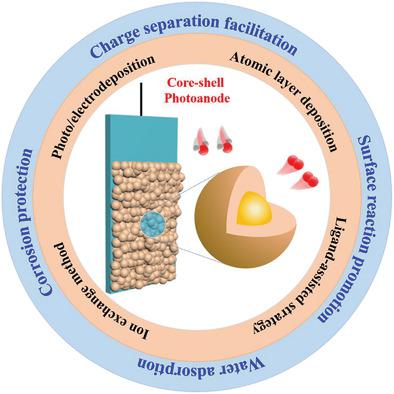当前位置:
X-MOL 学术
›
Adv. Funct. Mater.
›
论文详情
Our official English website, www.x-mol.net, welcomes your
feedback! (Note: you will need to create a separate account there.)
Core–Shell Photoanodes for Photoelectrochemical Water Oxidation
Advanced Functional Materials ( IF 18.5 ) Pub Date : 2021-06-25 , DOI: 10.1002/adfm.202104269 Jin‐Bo Pan 1 , Sheng Shen 1 , Lang Chen 1 , Chak‐Tong Au 2 , Shuang‐Feng Yin 1
Advanced Functional Materials ( IF 18.5 ) Pub Date : 2021-06-25 , DOI: 10.1002/adfm.202104269 Jin‐Bo Pan 1 , Sheng Shen 1 , Lang Chen 1 , Chak‐Tong Au 2 , Shuang‐Feng Yin 1
Affiliation

|
Photoelectrochemical (PEC) water splitting into hydrogen and oxygen is a promising solution for the conversion and storage of solar energy. Because sluggish water oxidation is the bottleneck of water splitting, the design and preparation of an efficient photoanode is intensively investigated. Currently, all known photoanode materials suffer from at least one of the following drawbacks: ① low carriers separation efficiency; ② sluggish surface water oxidation reaction; ③ poor long-term stability; ④ insufficient water adsorption and gas desorption. Core–shell configurations can endow a photoanode with improved activity and stability by coating an overlayer that plays energetic, catalytic, and/or protective roles. The construction strategy has an important effect on the activity of a core–shell photoanode. Nonetheless, the mechanism for the improvement of performance is still ambiguous and is worthy of a closer examination. In this review, the successes and challenges of core–shell photoanodes for water oxidation, focusing on synthesis strategies as well as functionalities (facilitating carrier separation, surface reaction promotion, corrosion prevention, and bubble detachment) are explored. Finally, the perspectives of this class of materials in terms of new opportunities and efforts are discussed.
中文翻译:

用于光电化学水氧化的核壳光阳极
光电化学(PEC)水分解成氢和氧是太阳能转换和储存的一种很有前途的解决方案。由于缓慢的水氧化是水分解的瓶颈,因此对高效光阳极的设计和制备进行了深入研究。目前,所有已知的光阳极材料都至少存在以下缺陷之一:①载流子分离效率低;②表面水氧化反应缓慢;③长期稳定性差;④水吸附和气体解吸不足。核壳结构可以通过涂覆一层起到能量、催化和/或保护作用的覆盖层来提高光阳极的活性和稳定性。构建策略对核壳光阳极的活性有重要影响。尽管如此,性能提升的机制仍然不明确,值得仔细研究。在这篇综述中,探讨了核壳光阳极用于水氧化的成功和挑战,重点是合成策略和功能(促进载流子分离、表面反应促进、腐蚀预防和气泡分离)。最后,讨论了此类材料在新机遇和新努力方面的前景。
更新日期:2021-09-03
中文翻译:

用于光电化学水氧化的核壳光阳极
光电化学(PEC)水分解成氢和氧是太阳能转换和储存的一种很有前途的解决方案。由于缓慢的水氧化是水分解的瓶颈,因此对高效光阳极的设计和制备进行了深入研究。目前,所有已知的光阳极材料都至少存在以下缺陷之一:①载流子分离效率低;②表面水氧化反应缓慢;③长期稳定性差;④水吸附和气体解吸不足。核壳结构可以通过涂覆一层起到能量、催化和/或保护作用的覆盖层来提高光阳极的活性和稳定性。构建策略对核壳光阳极的活性有重要影响。尽管如此,性能提升的机制仍然不明确,值得仔细研究。在这篇综述中,探讨了核壳光阳极用于水氧化的成功和挑战,重点是合成策略和功能(促进载流子分离、表面反应促进、腐蚀预防和气泡分离)。最后,讨论了此类材料在新机遇和新努力方面的前景。


















































 京公网安备 11010802027423号
京公网安备 11010802027423号